#halophyte plants
Explore tagged Tumblr posts
Text

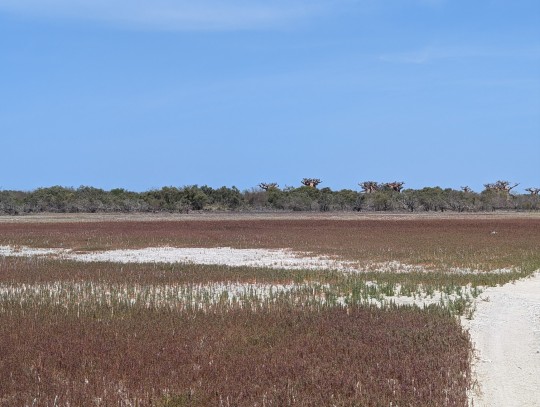

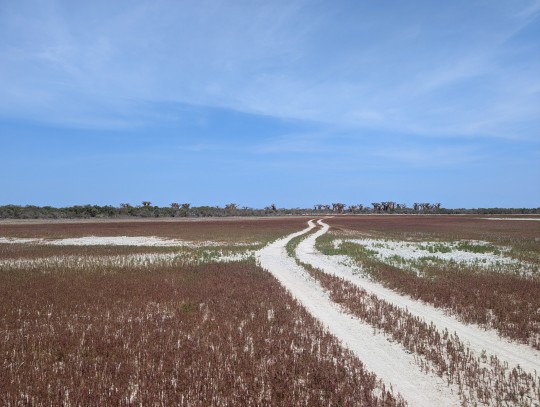
The red stuff is a halophyte (salt loving plant) and a succulent! Pickle weed I think they called it.
20 notes
·
View notes
Text
#2192 - Salicornia quinqueflora - Beaded Samphire


AKA Sarcocornia quinqueflora, bead weed, beaded glasswort, ureure in New Zealand or simply glasswort. The genus are also called Pickleweeds.
A succulent halophyte found wetter coastal areas of Australia and New Zealand, although it's not native to the latter. Oddly enough it's also found in two places in Central Otago in New Zealand, which is nowhere near the coast, but did use to have extensive salt pan habitat.
Historically, people used to burn glassworts to collect the ashes, for the soda content which was used to make soap and glass. It's also edible and the newer shoots quite palatable. Certainly the orange-bellied parrot (Neophema chrysogaster) thinks so - the seeds are a critical food, so the ongoing loss of samphire flats is a disaster for the 180 remaining birds.
Mascot, Sydney, New South Wales
1 note
·
View note
Note
hey!
🐍- How do you deal with it when you come across a plothole?
🕳️- Talk about a research rabbit hole you fell down!
Anyways, No pressure
Take your Time!
hello!!
Haha well historically I've just abandoned things because of plot holes, but I'm trying to sit down and commit to a long form work I've already put a lot of effort in!! So usually I'll just talk it through with some friends to try and find a solution. Sometimes it's just as simple as adding or removing an element from the worldbuilding.
As for research rabbit holes....
well, let's see I've also done some dives into Andean and Vietnamese agriculture to try and figure out food in project cannibalism. Quinoa plants are really fucking pretty guys. It grows in six foot stalks that can turn a range of colors from red to purple. The Hmong population in Vietnam also has indigenous strains of corn that they grind down and steam- a lot of them are in danger of extinction due to hybridization. It's an important staple crop for them!!
I've also looked into halophytes, plants adapted to high levels of salt, of which there are a large variety and some are edible! There's a "green salt" salt replacement that's just a dried halophillic sea pea plant, which I think is really interesting. There's also a database at ehaloph.uc.pt that's literally just for halophytes which even includes a filter for economic uses!
2 notes
·
View notes
Text
Excerpt from this story from National Geographic:
These days, the village of Karauzyak in western Uzbekistan is a dusty place. Surrounded by an arid landscape of dry scrub grasses and salt-crusted soils, it’s hard to believe the village was once along the banks of a swollen river, 30 miles from the shore of the world’s fourth-largest lake. Over the last 50 years, that lake, the Aral Sea, has dried up almost entirely, in what is often called the “world’s worst environmental disaster.” Now, it’s hard to farm much of anything in Karauzyak—except for atriplex, or saltbush.
In a 3.5-hectare plot of land near the village, a team of Japanese researchers is growing this salt-loving plant, known scientifically as a halophyte, to see if it can be a viable crop for farmers in the region and even nurture a small dairy industry. They’ve fed it to cows at a nearby farm and found that it helps lock scarce moisture into the thirsty soil, and it can be grown without extensive fertilizer use.
As she holds up a dusty green twig of atriplex, Kristina Toderich, a halophyte expert from Tottori University in Japan, explains why the salt-loving plant excites scientists like her: “This doesn’t need water. It doesn’t need anything.”
Toderich is one of the lead researchers on a project using the former seabed and nearby river delta as a living laboratory. It’s part of a larger Japanese foreign aid and scientific collaboration initiative called SATREPS. Working with Uzbekistan’s hydrometeorological service, UZGIP, the researchers are collecting real-time climate data and satellite imagery to better understand the conditions in the Aral Sea area: how much water is left, how fast it’s disappearing, and what kind of crops are being farmed there.
Based on the results, they’re drafting a model for sustainable agriculture in the region, recommending that farmers adopt new irrigation methods and plant crops that are more salt- and drought-tolerant, says Kenji Tanaka, a hydrologist who studies the effects of climate change on water resources and the head of the SATREPS project.
The United Nations Convention to Combat Desertification has warned that an area of land the size of Central Asia has become degraded from drought, salinization, and overuse since 2015. By learning what can grow in the Aral Sea, SATREPS could provide solutions for other parts of the world that are facing similar problems, from the Lake Chad basin in Western Africa to the Great Salt Lake in Utah.
It's unclear whether the Uzbeki government will adopt the recommendations made by the SATREPS team. But so far, the country seems open to change; President Shavkat Mirziyoyev, who promised to loosen the rigid Soviet-era policies of his predecessor, Islam Karimov, ended the requirement that all Uzbek citizens pick cotton if called upon, and has spoken at the United Nations about the effects of desertification and land degradation on his country.
Climate change makes these adaptations even more urgent. Average temperatures in the Aral basin have increased by around 3.6 degrees Fahrenheit since 1968. And the shrinking of the Aral Sea itself has affected the climate; as the water disappeared, the air became drier and lost the cooling effect of the nearby lake, creating a feedback loop that resulted in hotter and drier weather. Sandstorms now spread dust and toxic heavy metals to nearby villages, while retreating water has caused a build-up of salts in the soil.
Tanaka’s project has several components. Aside from atriplex, SATREPS researchers are planting crops like sorghum, mung bean, and amaranth in test plots to learn which can best survive in dry, saline soil. So far, they’ve developed promising varieties of winter wheat and barley.
6 notes
·
View notes
Text
Preserving Paradise: Sustainable Travel Practices in Sundarbans.
## Index
1. Introduction
2. Understanding the Sundarbans Ecosystem
3. The Importance of Sustainable Travel
4. Planning Your Sustainable Trip
- Choosing Eco-Friendly Accommodations
- Selecting Responsible Tour Operators
5. Minimizing Environmental Impact
- Reducing Plastic Use
- Waste Management
- Water Conservation
6. Responsible Wildlife Viewing
- Guidelines for Safe Wildlife Interactions
- Importance of Ethical Photography
7. Supporting Local Communities
- Engaging with Local Culture
- Purchasing Local Products
8. Sustainable Activities in the Sundarbans
- Eco-Tours and Wildlife Safaris
- Birdwatching
- Mangrove Planting Projects
9. Conclusion
## 1. Introduction
The Sundarbans, a UNESCO World Heritage Site, is one of the most unique and biodiverse regions on the planet. Home to the majestic Royal Bengal Tiger and an intricate network of mangrove forests, this paradise requires our utmost respect and care. Sustainable travel practices are essential to preserve the Sundarbans' delicate ecosystem and support the local communities. This blog will guide you through the best practices for sustainable travel in the Sundarbans.
## 2. Understanding the Sundarbans Ecosystem
The Sundarbans is the largest tidal halophytic mangrove forest in the world, spanning India and Bangladesh. It supports a wide array of flora and fauna, including endangered species like the Royal Bengal Tiger, estuarine crocodiles, and the Indian python. The mangroves play a crucial role in protecting the coastline from erosion and storms, making their conservation vital for the environment and the livelihoods of the people who live there.
## 3. The Importance of Sustainable Travel
Sustainable travel ensures that tourism does not negatively impact the environment or local communities. By adopting eco-friendly practices, travelers can help preserve natural habitats, reduce pollution, and support the socio-economic development of local communities. This responsible approach to tourism ensures that the Sundarbans can be enjoyed by future generations.
## 4. Planning Your Sustainable Trip
### Choosing Eco-Friendly Accommodations
Select accommodations that prioritize sustainability. Look for eco-resorts and lodges that use renewable energy, have waste management systems in place, and support local conservation efforts. These establishments often provide a more immersive experience and contribute directly to preserving the Sundarbans.
### Selecting Responsible Tour Operators
Choose tour operators committed to sustainable practices. Ensure they follow guidelines for wildlife interaction, use eco-friendly boats, and employ local guides. Responsible operators will prioritize the well-being of the environment and the communities over profit.
## 5. Minimizing Environmental Impact
### Reducing Plastic Use
Single-use plastics are a significant threat to the Sundarbans' ecosystem. Travelers should bring reusable water bottles, bags, and containers to minimize plastic waste. Many eco-friendly accommodations and tour operators provide refill stations to encourage this practice.
### Waste Management
Dispose of waste responsibly by following the principle of "Leave No Trace." Carry a small bag for collecting personal trash and dispose of it properly at designated locations. Avoid littering in the forest and waterways.
### Water Conservation
Water is a precious resource in the Sundarbans. Conserve water by taking shorter showers, reusing towels, and turning off taps when not in use. Eco-friendly accommodations often implement water-saving measures, and travelers should adhere to their guidelines.
## 6. Responsible Wildlife Viewing
### Guidelines for Safe Wildlife Interactions
Respect wildlife by maintaining a safe distance and not disturbing their natural behavior. Follow the guidance of your tour guide and avoid making loud noises or sudden movements. Feeding animals or attempting to touch them can harm both you and the wildlife.
### Importance of Ethical Photography
Wildlife photography should be conducted ethically. Use long lenses to avoid disturbing animals and never bait them for a better shot. Ethical photography ensures that wildlife remains safe and undisturbed, allowing them to thrive in their natural habitat.
## 7. Supporting Local Communities
### Engaging with Local Culture
Immerse yourself in the local culture by participating in community-based activities. Attend traditional dance and music performances, visit local markets, and learn about the way of life in the Sundarbans. This engagement helps preserve cultural heritage and provides economic benefits to the community.
### Purchasing Local Products
Support local artisans by purchasing handmade crafts and products. This not only provides a source of income for the community but also encourages the continuation of traditional skills and crafts. Avoid buying products made from endangered species or materials that harm the environment.
## 8. Sustainable Activities in the Sundarbans
### Eco-Tours and Wildlife Safaris
Participate in eco-tours and wildlife safaris that prioritize sustainability. These tours use eco-friendly boats, limit the number of visitors, and follow strict guidelines to minimize impact on the environment. They offer a chance to see the Sundarbans' wildlife up close while ensuring their protection.
### Birdwatching
The Sundarbans is a haven for birdwatchers. With over 300 bird species, including many migratory birds, birdwatching is a low-impact activity that can be enjoyed year-round. Use binoculars and maintain a respectful distance to avoid disturbing the birds.
### Mangrove Planting Projects
Get involved in conservation efforts by participating in mangrove planting projects. These initiatives help restore degraded areas, support wildlife habitats, and protect the coastline. Many local organizations offer opportunities for tourists to contribute to these projects.
## 9. Conclusion
Preserving the Sundarbans' unique ecosystem and cultural heritage requires collective effort from both tourists and local communities. By adopting sustainable travel practices, such as choosing eco-friendly accommodations, minimizing environmental impact, engaging in responsible wildlife viewing, and supporting local communities, we can ensure that this paradise remains a vibrant and thriving destination. Sustainable travel not only protects the environment but also enriches the travel experience, allowing visitors to connect deeply with the natural beauty and cultural richness of the Sundarbans. Let's commit to preserving this paradise for future generations to enjoy.
https://sundarbanecotrip.com
0 notes
Text
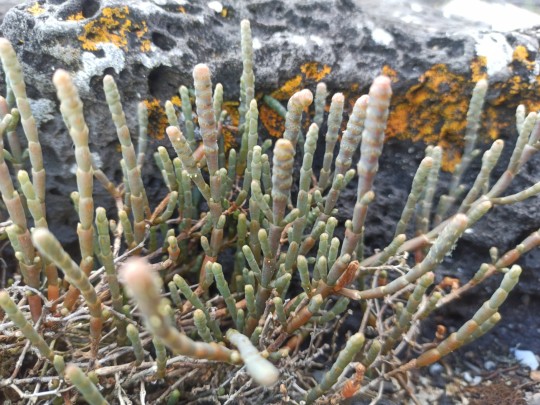
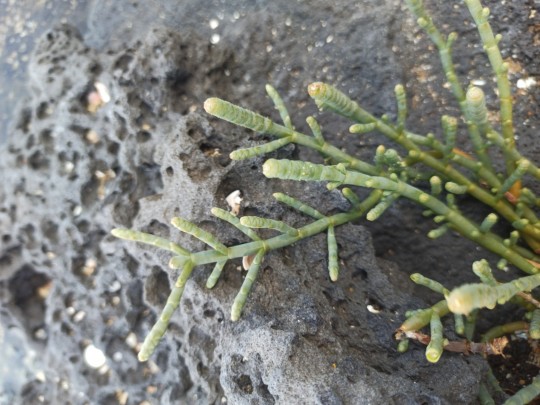
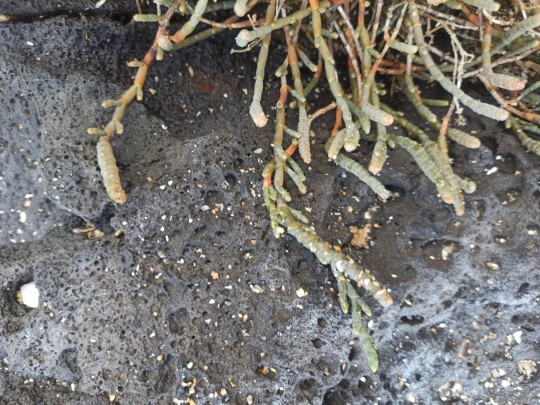
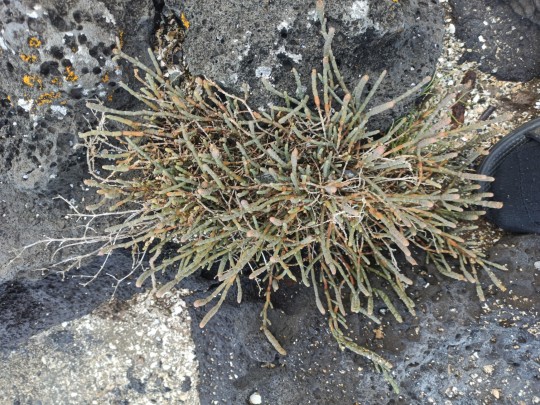
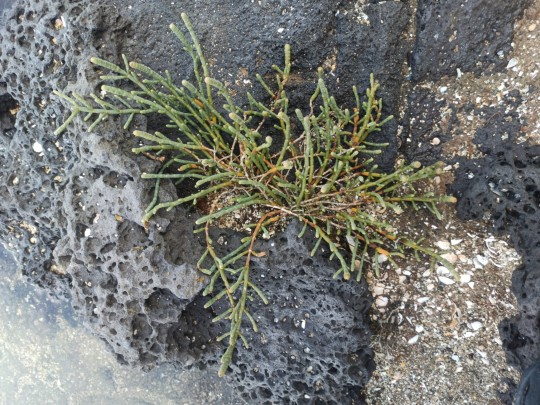

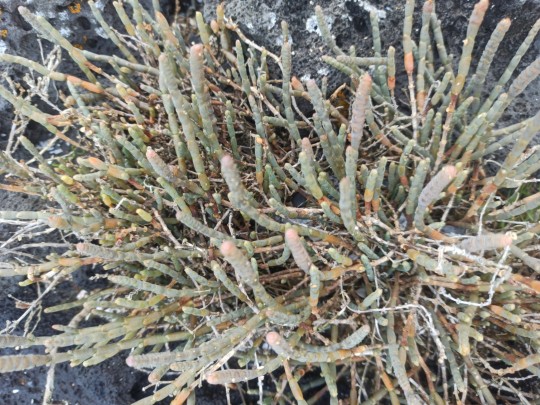

Salicornia quinqueflora, synonym Sarcocornia quinqueflora, commonly known as beaded samphire, bead weed, beaded glasswort or glasswort, Бусинная стеклодувная, The Maori name is ureure, is a species of succulent halophytic coastal shrub.
Clade:Eudicots
Order:Caryophyllales
Family:Amaranthaceae
Genus:Salicornia
Historically, people used to burn glassworts to collect the ashes. The ashes contained a high amount of soda in them, which was used to make soap and glass. This is thought to be how glasswort received its name. salt tolerant plant. It occurs in wetter coastal areas of Australia and New Zealand.
Листья выглядят как крошечные лопасти, обвитые вокруг стебля.
Стеклянница съедобна и вкусна, поэтому, как известно, употреблялась как животными, так и людьми. Рекомендуется есть свежие, молодые, верхние части стеблей сырыми, так как они нежные и более ароматные. Люди могут есть в салате, также можно использовать в качестве гарнира с морепродуктами, хорошо в супах или тушеным для дополнительного вкуса или может быть подано в качестве горячего овоща, можно мариновать.
Он богат витаминами С, А и комплекса В, а также был описан как помогающий метеоризму и пищеварению, был упомянут, как возможное средство для лечения рака.
Te Araroa Trail, Auckland 0622, 6QFG+2GH Auckland
-36.7774360, 174.7763470
наземные цветковые растения травы съедобные прибрежные
0 notes
Link
Biology and Ecology of Pharmaceutical Marine Plants, ISBN-13: 978-0815393870 [PDF eBook eTextbook] Series: Biology and Ecology of Marine Life 504 pages Publisher: CRC Press; 1 edition (June 12, 2018) Language: English ISBN-13: 978-0815393870 ISBN-10: 0815393873 Marine plants such as algae (blue-green algae and seaweeds), seagrasses, mangrove plants, salt-tolerant or salt-loving plants (halophytes) and coastal sand dune plants are known to generate approximately 70% of oxygen on earth, and help regulate oxygen in the atmosphere. These plants are potential sources of nutrients and are also considered valuable for the development of new drugs owing to their unique bioactive compounds. This book provides the taxonomy, common name, global distribution, habitat, diagnostic features and pharmaceutical compounds (along with their activities) of 400 species of marine plants, accompanied by high quality illustrations. Biology and Ecology of Pharmaceutical Marine Plants is the first comprehensive book of its kind written by scientists from both the Marine Biology and Pharmacy disciplines to fill the long-felt need for a marine natural products book devoted exclusively to plants. It should be a standard reference for students, researchers and teachers of disciplines such as Pharmacy, Fisheries Science, Marine Biology, Life Sciences, Biotechnology and Biochemistry, as well as a valuable guide for pharmaceutical companies involved in the development of new drugs from marine plants. Key features: – A standard reference for researchers, teachers and students of Marine Biology, Fisheries Science, Botany/Plant Science, Biotechnology, Natural Products, and Pharmacy, their libraries – A valuable guide for pharmaceutical companies involved in the development of new drugs from marine plants – Presents the taxonomy, common name, global distribution, and habitat of 400 species of marine plants – Provides the diagnostic features and pharmaceutical compounds (along with their chemical structure and activities) of 400 species of marine plants – Includes more than 600 detailed illustrations – Covers blue-green algae, green algae, brown algae, and red algae What makes us different? • Instant Download • Always Competitive Pricing • 100% Privacy • FREE Sample Available • 24-7 LIVE Customer Support
0 notes
Text
We have a very similar plant in the Canadian prairie provinces that I see all the time. I believe the scientific name is Salicorna Rubra , but most people just call it “ the red plant “ or “ the slough plant “. It’s interesting how a number of halophyte plants seem to have red adaptations.

So many colors! I’m starting to love fall on the marsh. The red spot is red saltwort or Rocky Mountain saltwort. It’s a really special species to see as it’s only found in high elevations or latitudes and has to be in soils with high salinity. It’s considered extinct in a few states and is protected in others. The photo doesn’t even capture how vividly red it is. This is a relatively small patch compared to others I’ve seen around, but I thought it was especially beautiful with the turning bulrush and mountains.
634 notes
·
View notes
Link
Biology and Ecology of Pharmaceutical Marine Plants, ISBN-13: 978-0815393870 [PDF eBook eTextbook] Series: Biology and Ecology of Marine Life 504 pages Publisher: CRC Press; 1 edition (June 12, 2018) Language: English ISBN-13: 978-0815393870 ISBN-10: 0815393873 Marine plants such as algae (blue-green algae and seaweeds), seagrasses, mangrove plants, salt-tolerant or salt-loving plants (halophytes) and coastal sand dune plants are known to generate approximately 70% of oxygen on earth, and help regulate oxygen in the atmosphere. These plants are potential sources of nutrients and are also considered valuable for the development of new drugs owing to their unique bioactive compounds. This book provides the taxonomy, common name, global distribution, habitat, diagnostic features and pharmaceutical compounds (along with their activities) of 400 species of marine plants, accompanied by high quality illustrations. Biology and Ecology of Pharmaceutical Marine Plants is the first comprehensive book of its kind written by scientists from both the Marine Biology and Pharmacy disciplines to fill the long-felt need for a marine natural products book devoted exclusively to plants. It should be a standard reference for students, researchers and teachers of disciplines such as Pharmacy, Fisheries Science, Marine Biology, Life Sciences, Biotechnology and Biochemistry, as well as a valuable guide for pharmaceutical companies involved in the development of new drugs from marine plants. Key features: – A standard reference for researchers, teachers and students of Marine Biology, Fisheries Science, Botany/Plant Science, Biotechnology, Natural Products, and Pharmacy, their libraries – A valuable guide for pharmaceutical companies involved in the development of new drugs from marine plants – Presents the taxonomy, common name, global distribution, and habitat of 400 species of marine plants – Provides the diagnostic features and pharmaceutical compounds (along with their chemical structure and activities) of 400 species of marine plants – Includes more than 600 detailed illustrations – Covers blue-green algae, green algae, brown algae, and red algae What makes us different? • Instant Download • Always Competitive Pricing • 100% Privacy • FREE Sample Available • 24-7 LIVE Customer Support
0 notes
Link
Biology and Ecology of Pharmaceutical Marine Plants, ISBN-13: 978-0815393870 [PDF eBook eTextbook] Series: Biology and Ecology of Marine Life 504 pages Publisher: CRC Press; 1 edition (June 12, 2018) Language: English ISBN-13: 978-0815393870 ISBN-10: 0815393873 Marine plants such as algae (blue-green algae and seaweeds), seagrasses, mangrove plants, salt-tolerant or salt-loving plants (halophytes) and coastal sand dune plants are known to generate approximately 70% of oxygen on earth, and help regulate oxygen in the atmosphere. These plants are potential sources of nutrients and are also considered valuable for the development of new drugs owing to their unique bioactive compounds. This book provides the taxonomy, common name, global distribution, habitat, diagnostic features and pharmaceutical compounds (along with their activities) of 400 species of marine plants, accompanied by high quality illustrations. Biology and Ecology of Pharmaceutical Marine Plants is the first comprehensive book of its kind written by scientists from both the Marine Biology and Pharmacy disciplines to fill the long-felt need for a marine natural products book devoted exclusively to plants. It should be a standard reference for students, researchers and teachers of disciplines such as Pharmacy, Fisheries Science, Marine Biology, Life Sciences, Biotechnology and Biochemistry, as well as a valuable guide for pharmaceutical companies involved in the development of new drugs from marine plants. Key features: – A standard reference for researchers, teachers and students of Marine Biology, Fisheries Science, Botany/Plant Science, Biotechnology, Natural Products, and Pharmacy, their libraries – A valuable guide for pharmaceutical companies involved in the development of new drugs from marine plants – Presents the taxonomy, common name, global distribution, and habitat of 400 species of marine plants – Provides the diagnostic features and pharmaceutical compounds (along with their chemical structure and activities) of 400 species of marine plants – Includes more than 600 detailed illustrations – Covers blue-green algae, green algae, brown algae, and red algae What makes us different? • Instant Download • Always Competitive Pricing • 100% Privacy • FREE Sample Available • 24-7 LIVE Customer Support
0 notes
Text
#2191 - Suaeda australis - Austral Seablite

AKA Redweed.
After we'd moved to a much better hotel immeadiately adjacent to the airport, I walked across the freeway to investigate a few parks I saw on the map. They were dissapointing - large trees, certainly, but lawn underneath, and not even any gardens to investigate. I did find a few halophytes in low, damp, presumably salty area of reclaimed land next to the sports ovals and tennis courts, though. Not immeadiately adjacent to the estuary, but probably very close to the water table.
Suaeda australis is an Amaranth native to Australia, growing to about 90cm tall, wth succulent green or pinkish-red foliage.It grows in coastal, estuarine, and salt marsh areas in all Australian States, where it grows in irrigated areas it's a good indicator of salinity problems.
Mascot, Sydney, New South Wales
1 note
·
View note
Photo
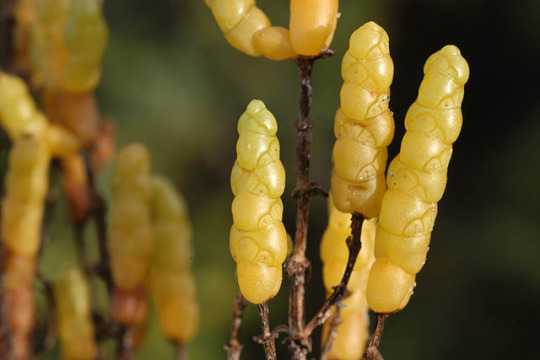
Salicornia brachiata
Umari Keerai
(via)
#Salicornia brachiata#Salicornia#succulent#halophyte#salt water plant#Umari Keerai#yellow#extremophile#edible#salty
74 notes
·
View notes
Photo

Gods of Salt, or the “““real””” origins of humankind
Might as well post it here directly. (original link, full text under the cut)
« Certainly Nature, when she left the making Of animals like these, did well indeed, By taking such executors from Mars; And if of elephants and whales she doth not Repent her, whosoever looketh subtly More just and more discreet will hold her for it; For where the argument of intellect Is added unto evil will and power, No rampart can the people make against it. » – Inferno, Canto XXXI, 49-57
Consider the following facts:
#1: The Mediterranean Sea loses more water to evaporation than it receives from rivers: it only maintains its level thanks to influx from the Atlantic. Between 6.0 and 5.3 million years ago, in the late Miocene epoch, the closure of the Gibraltar Strait caused the Mediterranean to dry out. This is known as the Messinian Salinity Crisis, and it left vast deposits of gypsum and rock salt. At its apex, this event would have reduced the sea to a few puddles of hypersaline water, similar to today's Dead Sea, surrounded by scorching desert - with temperatures possibly reaching over 40°C due to high pressure. Its islands and peninsulas would have turned to massive mountain ranges up to 5 km tall ([1]). This event ended with the so-called Zanclean Flood, when the Atlantic waters rushed back into the basin, through not one but a series of waterfalls. The overall drop was more than a km, and the discharge of water has been estimated at a thousand time that of the Amazon River ([2]). That's enough to refill the whole Mediterranean in less than 20 years. A sumberged barrier, known as Camarinal Sill, forms the shallowest part of the strait, at only 280 meters below sea level ([3]).
#2: Nevertheless, despite its terrible conditions, the Mediterranean Basin still had enough hospitable land to allow animals to move from Africa to Europe, and vice versa. In fact, the climate, flora, and fauna of Africa and Europe were very similar in the Miocene. Dwarf species of hippopotami and elephants have been found in Cyprus, Crete, Malta, Sicily, Sardinia, the Balearics: all the main islands of the Mediterranean. The lowland-dwellers could have lived along rivers like Po, Rhone, and Nile, which would have cut much deeper valleys.
#3: The Miocene was also a time of great diversity of mammals. In particular, it was the golden age of elephants (which existed in every continent but Australia) and apes (which were even abundant in Europe). European apes included the swamp-dwelling Italian Oreopithecus, 9-7 million years old, which had a pelvis suited for an almost bipedal locomotion ([4]), and hands more capable of precision gripping than those of any living non-human ape ([5]). As for elephants, Primelephas, the likely common ancestor of mammoths and all living elephants, lived in Africa at the end of the Miocene.
#4: Molecular studies place the separation between the lineages of humans and chimpanzees between 7 and 5 million years ago, later than Oreopithecus, and corresponding with the Messinian event. Recent estimates push the divergence backward, even to 10-12 million years ago; however, controversial studies suggest that the two lineages exchanged genes as recently as 4 million years ago ([6]). Clearly the process of separation was more complex than we realized at first, and involved some degree of hybridization between the recent lineages.
#5: The Mediterranean region contains a vast diversity of halophytes, plants than can grow despite high concentrations of salt. Many of these are suitable for human consumption: the oil-rich salicornia (Salicornia sp., eaten both fresh and pickled), the cabbage-like sea kale (Crambe maritima, which grows spontaneously on sandy beaches), the spinach-like sea orach (Atriplex halimus, a close relative of which is grown in India as vegetable and livestock fodder). The argan tree (Argania spinosa) is extremely resistant to both salt and drought, and is prized in Europe and North Africa for its wood and oil. ([7])
#6: The list of Mediterranean halophyte species is actually much wider, but many plants that grow in these conditions are not useful to humans: for example, the Mediterranean beard-grass (Polypogon maritimus), a close relative of oat and wheat, much less nutritious than either. Note, however, that elephants (much more common and diverse in this region in the Miocene) have very low nutritional requirements, and can feed on almost any type of vegetable matter. Now, a key characteristic of the Miocene epoch is a wide spreading of grasslands, replacing the forests that earlier covered most of the globe, triggering a wave of adaptation and diversification among mammals. In fact, between 10 and 5 million years ago, the diet of elephants has switched from leaves to tall grass, a change that can be seen in the shape of their teeth ([8]). Only in the last million years elephants have reverted to eating leaves ([9]).
#7: Until recently, the divergence between humans and chimpanzees had been linked to this event: the ancestors of chimpanzees would have remained in the thick rainforests of West Africa, while humans evolved in the new savannas of the east. This places human evolution entirely in eastern and southern Africa until the last million years or so. This view has been challenged by recent finds. In 2002, the 7-6 million years-old Sahelanthropus tchadensis, a serious contender as common ancestor of humans and chimpanzees, was discovered in Chad, in North Africa. Its foramen magnum suggests an already bipedal pace, as with Oreopithecus ([10]). In 2017, curiously human-like teeth, 7.2 million years old, were attributed to Graecopithecus, in Greece ([11]). Finally, in the same year, 5.6 million years old footprints that clearly show bipedal locomotion were found in Crete ([12]). All of this suggests that the earliest human evolution occurred at first in the Mediterranean region.
#8: The intelligence of elephants is well known. Their brain, over 5 kg heavy, has more cortical gyres than any primate or cetacean, and they might rank in intelligence besides chimps and dolphins ([13]). They form matriarchal herds with extremely strong interindividual bonds and great capacity for cooperation and reciprocal help. They are the only known non-human animals that seem to have ritual behavior related to death ([14]). Pregnant elephants have been observed chewing on leaves of a Boraginacean tree, used to induce labor or miscarriage by Kenyan women ([15]). They can use branches as simple tools, cover water pools to prevent evaporation, and use logs to disable electric fences ([16]). They can recognize themselves in the mirror ([17]), and seem to have artistic inclinations ([18]). Such abilities are especially astonishing in view of such an energy-poor diet. Yet we have seen that their diet was very different in the latest Miocene - that there are plants that grow in the Mediterranean region, could be eaten by ancient elephants, increased in diversity at that time, and are closely related to our food crops.
#9: The elephants' trunk is a dexterous organ of manipulation, capable of handling single seeds and inspecting delicate bodyparts like eyes. Nevertheless, having only one grasping organ could be a handicap for an active tool user (the two fingerlike tips are unique to the African species, and probably didn't exist in Miocene elephants). The trunk can lift loads of hundreds of kilograms, but it's poor at grasping large objects, and can only wrap around them. In comparison, the hands of apes are much more versatile, especially after the innovation we have seen in Oreopithecus. In addition, the same amount of food that sustains an elephant with its single trunk can support not two, but several ape hands - especially since high-energy primate food can pack nourishment in a much smaller mass, even when inedible to elephants. #10: African elephants in reserves readily initiate contact with humans, often forming long-lasting individual bonds, and often prefer to interact with humans than with other animals of their environment. Many of these elephants appear more relaxed and at ease near humans than near even other elephants. This effect has been documented in species with a long history of domestication by humans, such as dogs and horses. ([19]).
Let's place everything together. Six million years ago, near the end of the Miocene epoch, the natural closure of the Gibraltar Strait turned the Mediterranean Sea into a salty desert. The few inhabitable spaces provided a safe passage between Africa and Europe for many species; elephants and apes, which had been increasing in diversity for all the Miocene, were among them.
The depths of the new Mediterranean basin, on the other hand, were a hellish environment that must have forced many species into desperate adaptations. Many plants learned to grow in sand, long before the Sahara became a desert, with concentrations of salt that would kill most others. Elephants, we've seen, are good at finding and storing water, using tools to prevent evaporation from reserves. They must have evolved their characteristic intelligence to deal with the unique challenges of the Mediterranean Basin. Like the Khoisan hunter-gatherers of the Kalahari desert (or for that matter the earliest Homo sapiens) they needed advanced problem-solving skill, good memory, and the ability to cooperate and trust each other. Their eventual solution to ensure themselves a food supply in the great basin was agriculture. Many Mediterranean halophytes are edible even in the seed- and fruit-focused human diet; but the sapient elephants of the Miocene could feed even on simple grass. Cereals like Polypogon - which are, after all, nothing more than especially nutritious grass - must have been a blessing. Perhaps they were even selected artificially to tolerate more saline soils, as could have been the precious argan tree.
Still, the burgeoning elephantine civilization was slowed down by their sluggish reproduction and by their limited capacity for manipulation. The trunk was very effective, but every elephant could only hold one thing at a time. They must have experimented with many forms of animal labor (as well as hydraulic, etc.), but none of the many animals of their region could help them handle objects, make cheap craftwork, or operate machines. Eventually, they started working with apes. Maybe they took a sample of Oreopithecus descendants or Graecopithecus from the northern highlands. They were clever animals, forged by the same cruel environment, capable of understanding gestures and executing simple orders. They wouldn't take away the hard leaves and grass of their masters, but they would eat almost anything else (to the elephants, the ability to digest meat must have seemed extremely precious). They had hands: two hands to grasp a broad object without handles, to scatter seeds on a field, or to hold hammer and chisel in the making of a triumphal arch. So the elephants found themselves ruling over a vast caste of small, nimble, infinitely versatile slaves. Surely they must have tried to enhance them through selective breeding, as humans did with dogs and horses, creating features similar to the short jaws and small teeth of humans, or the peaceful countenance of bonobos. Their genes still bear traces of closely related lineages being interbred. They certainly encouraged a bipedal gait, so that the precious hands remained always free. With ape-servants so common and useful, crawling all around like living robots, elephants must have had little incentive to improve their technology further.
Remember the air at the bottom of the Basin was very thick: it's likely the elephants were specially adapted to breathe it, and would feel much discomfort outside of their cradle. They never ventured beyond what today is the coastline of the Mediterranean, which must have looked like impassable mountains to them. However, they could have sent their servants in exploration on the great islands: leaving, for example, the mysterious footprints of Crete. The proboscidean rulers probably didn't have much more concern for their primate slaves than humans have for cows in a slaughterhouse. Even though they couldn't eat them, they could still fashion their skins and bones into precious objects; sacrifice them to elephantine gods atop of a ziggurat raised by their work; make them fight in blood games or proxy battles; use them for carnal gratification or for medical experiments. The different proclivities of humans, bonobos, and chimpanzees can be understood as specialization for such tasks. We can only wonder what the apes could understand of their condition.
The civilization of elephants had 600,000 years to develop between the Messinian Crisis and the Zanclean Flood: thrice the age of our own species. Certainly they studied in depth their secluded world. As the sea level started to increase on the Gibraltar Strait, they would have probably predicted the danger, and built a massive dam to block the way of the Atlantic waters. Maintaining this dam must have been the highest priority. But there were certainly those who didn't believe this looming danger. And in the end the central sin of the elephantine empire must have caught up to them. What could have distracted the elephants from preserving the Mediterranean Basin as they found it? Probably action from those who had nothing to lose from utter destruction - such as ape-slaves who had finally crossed the threshold of self-awareness. Or rather a preemptive action from those who feared a revolt more than their own annihilation? Some kind of sabotage action, perhaps, that ended a millennia-spanning history by breaking down the great dam, letting the ocean pour into the Basin with an unimaginable catastrophe, and turn it back into a sea.
Some survived, both apes and elephants. They must have been few, perhaps outcasts that had fled, or had been exiled, to the outer highlands. Gradually they accustomed themselves again to the thin air (maybe this didn't even require evolutionary adaptation, just individual assuefaction; but the lords below were used to comfort...). Some were stranded on the new islands, and became the dwarfs of Cyprus, Crete, Sicily. The others scattered into the wilderness of Africa and Europe. Without the infrastructures of the submerged empire, unprepared for the different environment outside, they were unable to rebuilt their civilization. Most of them had been poorly inserted in society, and their intellective faculties weren't the highest, either as a cause or a consequence of their isolation. Alone, they reverted to wild animals, and became gentler than they ever had been when they were civilized beings. They still retain the vestigial skills of artists and doctors; they still mourn the death of their kin. The surviving apes, now free, wandered back into the heart of Africa, passing through Chad. Some found shelter in the jungles of Congo and Nigeria, others in the savannas of Kenya and South Africa, that perhaps reminded them of the flat lands where they were bred into their new shape.
Five million years after that unimaginable disaster, silt has covered all the ruins on the Mediterranean seafloor, and the "domesticated apes" have left Africa in three waves of migration. Now they control the world, from coastlines to mountains, they remake its land into cities and farms, and they hold in their power the fate of the distant descendants of their ancient masters. It remains to be seen whether they will choose to be merciful or vindictive. Aren't five million years enough to expiate any sin?
70 notes
·
View notes
Text
Ocean Empire Crop Calendar
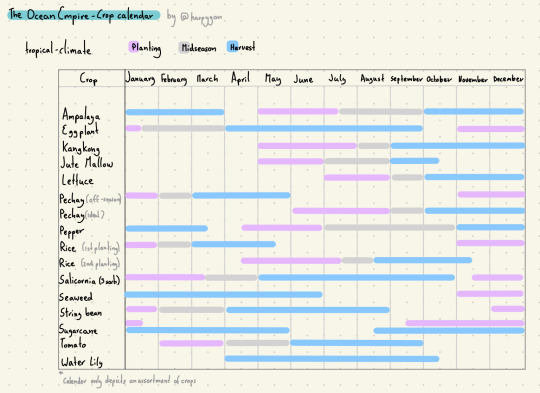
[Grimlands] [House Blossom] [Gilded Helianthia]
detailed thoughts (and information about crops depicted) under the cut
Jute Mallow isalso known as „bitter melon“ „bitter apple“ „bitter squash“ and bcountries specified as lying in the tropical zone (dependent on the list there might be more or less), I chose to look at the south-east Asian countries of Indonesia, Malaysia and the Philippines, the last being my main point of comparison.
The problem with the ocean empire is that it seems to have extremely limited planting ground (not taking into account soil under the ocean), meaning that most crops aren't really plantable.
In the beginning, I thought this was it, the ocean empire would have to live off fish, seafood and seaweed, but then I found hope.
This article talked about salt water rice, and while this example is made through human gene mutation, I'll assume that it naturally exists in the ocean empire.
Furthermore, we see lily pads being used a lot in the ocean empire, which his helpful, as (almost) the entirety of it is edible. Not only that, but the seeds can be ground into flour, meaning we have more options for filling foods such as bread. (There are no regular planting or harvesting seasons, as they just die back to their roots and then regrow later and different harvestable parts get harvested at different points in the year, so I just made a rough estimate based on the flowering time of the lilies) (out of context but one can make silk out of lotus flowers meaning that silk clothing made out of lotus flowers would be worn)
Seaweed itself would be growable almost everywhere where a water height of ca. 6 metres is present, and they are harvestable every 45-60 days (sources differ). The main harvest season spans January June.
Halophytes or salt-loving plants, form another big category of plants that could be planted. There are 3 sorts of halopythes, but we will only focus on Aqua-halines and then the subgroups of Hydro-halophytes (whole or almost whole plant remains under water) and Emerged Halophytes (most of the stem remains above the water level).
Most plants with the prefix „sea“ don‘t actually grow in the sea, as I sadly had to learn. But they are more salt tolerant than other plants which is why I will include some of them.
One of the best known ones is Salicornia. Salicornia europaea (underwater asparagus or sea pickles) is completely edible raw and cooked. Salicornia bigelovii is an oil crop, reaching about 60cm In height. Salicornia brachiata can be made into a culinary salt (substitute). They grow year round, but are planted in the “colder“ months of the year, meaning the cold dry period between December/November and February/March.
Now I thought the crop calendar looked pretty sad wit’s just those few plants, so I looked at foods commonly grown in The Philippines and picked some examples as things that could be grown on the little overwater soil they have.
I believe that on the shorelines of the little land they do have, people would plant sugarcane. It can be used as both a sweetener and just an ingredient for normal cooking. The harvest and planting seasons do overlap, which is why the crop calendar shows two rows instead of one.
Ampalaya, also known as „bitter melon“ „bitter apple“ „bitter squash“ and “balsam pear“ is a vine that produces a fruit, that is pretty bitter. It takes between 80 and 120 days to grow (differs based on sunlight sensitivity)
Kangkong or “water spinach“ is a form of spinach. It grows extremely quickly (just thirty days) and starts flowering in October. It is technically plantable year round, but as the seeds only mature by end of April and the plants are uprooted at the end of harvesting season, I assumed that they could only be planted after April (this could of course be altered by saving seeds or planting Kangkong off season)
Jute Mallow is a leafy plant with a slimy texture (similair to that of okra).
Pechay or „Chinese cabbbage“ is a cabbage. It has two main harvest seasons, one set in the “ideal“ season meaning the hot wet season and one in the cold dry off season.
String beans are a type of green bean.
Conclusion: The majority of the Ocean‘s empires cuisine would be based around rice, seaweed, various halophytes, and water lilies. However, the little overwater soil they do have allows for them to have a wide selection of vegetables, fruits and spices.
19 notes
·
View notes
Text
Expo 2020 Dubai Sustainability Pavilion Building
Expo 2020 Dubai Sustainability Pavilion Building, Architect, UAE Design Project Photos
Expo 2020 Dubai Sustainability Pavilion Design
6 October 2021
Design: Grimshaw Architects
Photos by Phil Handforth
Terra – The Sustainability Pavilion at EXPO 2020 Dubai
Terra – The Sustainability Pavilion, opened to the public in 2021 as one of the top three attractions of the Dubai Expo 2020, and aims to illuminate the ingenuity and possibility of architecture as society looks to intelligent strategies for future sustainable living.
photograph : Dany Eid / Expo 2020
Drawing inspiration from complex natural processes like photosynthesis, the dynamic form of the Pavilion is in service to its function, capturing energy from sunlight and fresh water from humid air. The relationship of building to site, and to its physical and cultural contexts is critical, as the facility’s strength lies in its capacity to demonstrate a new way of living sustainably in a challenging desert environment.
Sited in a prominent location, the Pavilion structure works in tandem with the considered landscape of demonstration gardens, winding pathways and shaded enclaves to create an aura of magic punctuated by the sights, smells and tactile opportunities of nature. The gardens are both experiential and functional, setting the stage for the exhibition contents within and creating shaded gathering areas that will manage and distribute crowds while providing retail, food and beverage opportunities.
When creating a building with a goal of generating its own energy and water in a harsh climate, the solution cannot be driven by a single aspect of the design. To achieve net-zero, the design required a series of technologies, building systems and design solutions to act in unison. This self-contained, micro-ecosystem resulted from a combination of strategies: optimizing the natural conditions inherent in its location; working with and within them to maximize efficiency; and supplementing them with pioneering sustainable technologies to create innovative solutions
The design is driven by maximizing efficiency which it does by seeking shade in the one place available: below the ground. The Pavilion uses the insulating properties of the earth to shield it from the harsh ambient temperatures which can soar to 50 degrees in the warmer months.
photo : Dany Eid / Expo 2020
Most of the accommodation is below grade and cased with an earth roof system, creating a substantial barrier to help reduce its cooling loads and conserve energy. The above ground surfaces are clad with a gabion rainscreen wall – sourced with local stone from the Hajar Mountains – which provides enough thermal mass to absorb the heat while the stone’s natural color reflects the sun.
Flora and fauna sourced from the surrounding deserts – including some species that have been never been cultivated by humans – are arranged on the planted roofs and throughout the gardens, creating a water efficient landscape that functions through a series of closed loop systems designed to filter, supply and recycle water. The framing of these local topographical and floral features, combined with the technologies of water recycling and reuse, provide visitors a newfound appreciation of the unique region and its biodiversity. The site also includes areas for productive agricultural landscape featuring halophytic agriculture and other testing beds.
The culmination of the building’s systems can be found in the heart of the Pavilion, its large exterior courtyard. Borrowing from the vernacular of the region, the courtyard provides a large, passively cooled space for visitors. During the design, thermodynamic studies charting the prevailing breezes were used to shape the courtyard to allow desirable cool south-westerly breezes to enter while blocking warmer winds.
Soaring over the courtyard, the Pavilion’s canopy accommodates more than 6,000 sqm of ultra-efficient monocrystalline photovoltaic cells embedded in glass panels. The combination of the cell and the glass casing allow the building to harness solar energy while providing shade and daylighting to the visitors below. The experience in the courtyard is of being beneath a large shade tree with dappled light projecting onto the surfaces below. The form of the canopy works with the courtyard to direct cool air in, while simultaneously exhausting low-lying hot air through a chimney effect at the centre.
The canopy also serves as a large collection area for stormwater and dew that replenishes the building’s water system. The result is a structure that combines the most advanced technology in solar capture and a clear understanding of the natural conditions of the site to actively generate energy while passively cooling and enhancing the experience of the visitor. With over 6,000 sqm of exhibition space, the Sustainability Pavilion will enjoy a long life after Expo is over, transforming into a science museum and expanding on its mission of exploring sustainable practices and the critical stewardship of our fragile planet.
ENERGY E TREES The Sustainability Pavilion is complemented by an installation of Energy Trees which contribute toward its goal of producing its own energy. Nineteen E-trees ranging from 15-18m in diameter are dispersed throughout the site and provide 28% of the energy required to power the building. Inspired by the Dragon’s Blood, a tree found only on Socotra, an island 200 miles off the coast of Yemen, the E-Tree is designed to be a deployable freestanding shade structure that harvests the sun’s energy. The structure is constructed from steel and complex composites and has been optimized to support an 18m photovoltaic array.
Taking further cues from nature, the array follows the sun in the same manner as a sunflower, rotating 180 degrees throughout the course of the day to maximize the energy yield and increase the efficiency of the solar cells, before returning to its original position at night. Bespoke trapezoidal panels composed of highly efficient monocrystalline solar cells, embedded within three layers of glass, provide shade below without casting severe shadows or blocking views to the sky.
Supporting the array is an engineered carbon fibre structure inspired by the design of the steering wheel of a yacht. The structural design maximizes strength in its shape, with radial branches encircled by a compression ring while decreasing the load of the structure itself. Carbon fibre was chosen for its light weight which allows the form to extend unsupported for up to nine meters in all directions.
The E-Trees have become an integral part of both the exhibition and the Pavilion site – showcasing and educating visitors on the research on solar harnessing and panel technology – while at the same time, serving as an integral part of the systems that contributes to a net zero energy goal of the building.
photo : Dany Eid / Expo 2020
Terra Expo 2020 Dubai Sustainability Pavilion Design – Building Information
Project Data:
Client: Emaar Properties & Expo 2020 Dubai
Location: Expo Road Dubai South, Jebel Ali P.O. Box 2020 Dubai, United Arab Emirates
Website: https://ift.tt/3FmYDo0 Completion date: January 2021 Gross square footage: 17,000 sqm Project cost: confidential
Project Team:
Grimshaw: architect Buro Happold: engineering Desert Ink: landscape architecture
photo : Dany Eid / Expo 2020
Other Consultants:
Rice Perry Ellis: local architect Sherwood Design Engineers: civil engineering, water management Cerami: AV, IT, acoustics, security Tricon: food service Orca : crowd flow RWDI: climate analysis Thinc Design: exhibition design Eden Project: exhibition content TAW Weiss: maintenance Arch4Blind: accessibility Charcoal Blue: theatre design Lord Cultural: operations Friday Group: specifications
photo : Dany Eid / Expo 2020
Grimshaw Design Team:
Andrew Whalley – Chairman – Partner in Charge Matthew Utley – Principal – Director of Middle East Operations Mark Rhoads – Associate Principal – Project Director Casimir Zdanius – Associate Principal – Industrial Design Lead
Associate Principals: Iouyu Chen, Robert Young, George Hauner, Croz Crozling, Andrew Anderson
Associates: Jorge Salgado, Aimee Duquette, Aaron Vaden Youmans, Ross Goldsworthy, Woojae Sung, Andrea Debilio
Design Team: Zach Fine, Augustine Savage, Kyle Day, Renua Itsueli, Fernando Fisbein, Hannah Park, Anthony Mopty, Joana Torres, Justin Brammer, Mehnaj Tabassum, Diba Dayani, Mason Nabors, Albert Hsu, Kurt Hanzlik, Patricia McKee, Fan Cao, Kyle Spence, Vincent Velasquez, Max Dowd, Wooyoung Choi, Leland Jobson, David Mans, Greg Smith, Konrad Sobon, Raphael Ogoe, Alexandra Danciulescu
Photos: Phil Handforth
Sustainability Pavilion for Expo 2020 Dubai Design: Grimshaw Architects image courtesy of architects Sustainability Pavilion for Expo 2020 Dubai
Grimshaw
Expo 2020 Pavilion Abu Dhabi Sustainability
Expo 2020 Dubai Sustainability Pavilion building design images / information received 061021 from CRA-Carlo Ratti Associati Architects
Location: Jebel Ali, Dubai, UAE
Dubai 2020 Expo Pavilions
Dubai Expo UK Pavilion Design: Es Devlin photo by Alin Constantin ; image courtesy of Es Devlin Expo 2020 Dubai UK Pavilion Building
Dubai Expo Swedish Pavilion Building Design: Alessandro Ripellino Architects, Studio Adrien Gardère and Luigi Pardo Architetti photo courtesy of Swedish government Dubai Expo Swedish Pavilion Building
Dubai 2020 Expo Pavilions Design: Santiago Calatrava, Foster + Partners, BIG and Grimshaw Architects image courtesy of architects Dubai 2020 Expo Pavilions
2020 Expo Dubai Luxembourgish Pavilion Design: METAFORM Architects image courtesy of architects 2020 Expo Dubai Luxembourg Pavilion Building
Dubai World Expo 2010 Masterplan Design: HOK / Populous Dubai World Expo Masterplan
Grimshaw Architects
Dubai World Expo
UAE Architecture
Abu Dhabi Architecture Designs – chronological list
Dubai Buildings
Hyperloop Pods and Portals Design: BIG-Bjarke Ingels Group image from architects studio Hyperloop Pods and Portals in Dubai
Architecture Tours Dubai by e-architect
Dubai World Expo 2020
Comments / photos for the Expo 2020 Dubai Sustainability Pavilion Building design by Grimshaw Architects in UAE page welcome
The post Expo 2020 Dubai Sustainability Pavilion Building appeared first on e-architect.
2 notes
·
View notes
Text
Iris Publishers
Use of Salt-Tolerant Plants and Halophytes as Potential Crops in Saline Soils in China
Authored by Faisal M El Hag

Introduction
As one of the major abiotic stresses, salinity severely inhibits plant growth and development, leads to crop yield loss and plant ecosystem deterioration worldwide [1,2]. Sodium chloride is considered to be the most component that causing salinization and is the widespread salt that existing in saline soils [3]. UP to now, almost 10% of the land area and 50% of the irrigated soils area was affected by salinity presence [1,4]. In addition, the degree of soil salinization is still intensified due to natural and human factors such as irrational irrigation. Simultaneously, the agricultural land has declined due to the industrialization, the urban development, and the habitat need with the rapid increase of population [5]. Therefore, developing strategies to make use of saline land will be crucial for addressing the problem of insufficient farmland and meeting the challenge of providing food security for the projected global population of 9.3 billion people by 2050. It is considered as a desirable and sustainable strategy to plant the salt-tolerant crop varieties and halophytes for the agricultural usage of saline soils.
In general, the growth and the reproduction of crops were severely inhibited when they grow in saline environments [6], even died in heavily saline soils. 99.13 million hectares of saline-alkali land are present in China, accounting for about 12% of the world’s saline-alkali land, and more than 20 million hectares of land are considered to be saline, among which 20% are distributed in cultivated lands [7]. Many works have been done in getting a better and more efficient way to use of the salinized land by biological methods in China. In the present paper, applied and potential plants that could grow on saline land and with economic and application value will be discussed, which will provide an insight understanding and application reference for improving and using the saline soils for agriculture.
Discussion
There are about 420 halophyte species and more than 1000 salt-tolerant plants in China. In the current, a wide range of applications could be implemented according to the salt-tolerant plants and halophytes. Up to now, more than 100 species of the salt-tolerant plants and halophytes have been applied for improving saline lands in China. They could be used as food, such as the salt-tolerant wheat (Dekang 961, Shanrong 3), quiona, and sorghum; vegetables, such as Suaeda salsa, Salicornia bigelovii, and Ice plant (Mesembryanthemum crystalinum L.); forage, such as Atriplex triangularis, sweet sorghum, and wild soybean (Glycine soja Sieb. et Zucc.); fruits, such as winter jujube (Ziziphus jujuba cv. Dongzao), and Nitraria tangutorum; medicine, such as Glycyrrhiza uralensis Fisch, Apocynum venetum, and flower plant such as Limonium sinense. And bioenergy is considered as a renewable new energy.
With the rapid economy expansion, the demand for energy is sustaining insatiable. Bioenergy such as ethanol is selected as a new alternative energy source to meet the global requirement. In addition, to avoid the completion of food and farmland for people in China, the bioenergy is allowed to produce only in marginal soils such as saline soils by culturing the energy crops with higher salt-tolerant ability such as sweet sorghum, hybrid pennisetum, Manihot esculenta, and sugar beet [8,9,10]. Sweet sorghum with high salt tolerance, photosynthesis, high biomass and sugar content in the stem is widely planted in saline soil to be a suitable crop to produce the food, the animal feed, good liquor-making raw materials and bioethanol [11,12].
Halophytes could grow under extreme salt conditions with highly salt-tolerant ability, evenly at sea salt level [13]. As the precious plant resources with high applicable value, halophytes have been obtained more and more attentions by scientists [14]. For instance, to remediate the saline soils by culturing halophytes, preventing salt back to the soil surface, and removing salt from the soils that reducing salt content [5]. In addition, halophytes also have many economic values, for example, some of them could be used as vegetables, fodder and fruit [15,16]. Even some of the halophytic vegetables such as Suaeda salsa could be irrigated using seawater or grown in the intertidal zone [17]. It could be providing gourmet vegetables using seawater and meet the shortage of freshwater resources in the world [18]. Furthermore, halophytes have other usage, Suaeda salsa could be used to produce oil due to the abounded content of unsaturated fatty acid in their seeds [19,20]. Halophytes could provide abounded salt-tolerant genes for studying the salt tolerance mechanism and obtain the genetically modified salt-tolerant crops. Perhaps, the problem of “less land for more population” in the developing countries could be solved by planting salt-tolerant plants and halophyte on the saline soils and provide economic benefit and could meet the problem of the restricted agricultural land resources [21,22].
Conclusion
With the increasing of the saline areas and the degrading of the arable soils in the world, we face the problem of how to balance the reducing of farmland and the increasing of the requirement of food and energy. The growth, development and reproduction of all crops are severely inhibited by saline soils. While some of the salt-tolerant plants can grow in the saline conditions, which could utilize the saline soils by culturing salt-tolerant plants and provide us food, vegetables, fruits, animal forage, flowers and bioenergy. This will solve the contradiction between the increase in population and the decrease in cultivated land area, and at the same time, provide a better method to develop and utilize of saline land. Therefore, screening more salt-tolerant plant and halophytes with high potential value in agriculture is an urgent task
To read more about this article: https://irispublishers.com/wjass/fulltext/use-of-salt-tolerant-plants-and-halophytes-as-potential-crops-in-saline-soils-in-china.ID.000606.php
Indexing List of Iris Publishers: https://medium.com/@irispublishers/what-is-the-indexing-list-of-iris-publishers-4ace353e4eee
Iris publishers google scholar citations: https://scholar.google.co.in/scholar?hl=en&as_sdt=0%2C5&q=irispublishers&btnG=
1 note
·
View note